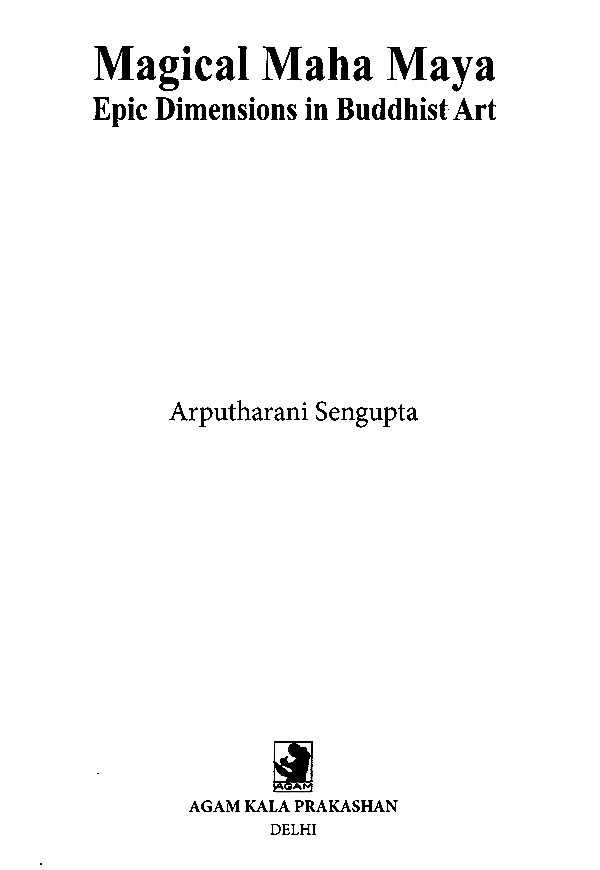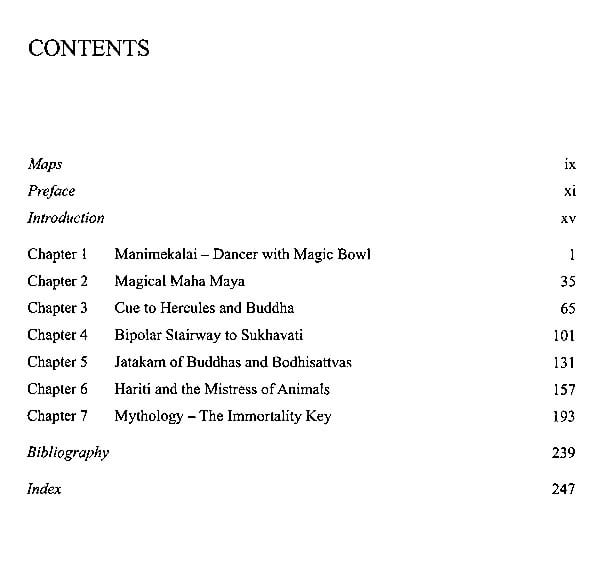
Magical Maha Maya- Epic Dimensions in Buddhist Art
Book Specification
| Item Code: | AZG171 |
| Author: | Arputharani Sen Gupta |
| Publisher: | AGAM KALA PRAKASHAN, DELHI |
| Language: | ENGLISH |
| Edition: | 2021 |
| ISBN: | 9788195009831 |
| Pages: | 286 (Throughout B/w Illustrations) |
| Cover: | HARDCOVER |
| Other Details | 11.00x9.00 inch |
| Weight | 1.40 kg |
Book Description
The interactive cultural production of the Greco-Kushan period intersects mythologies and ancient Mysteries of the Roman world. The interface provokes new transformative learning. The Apollo type of Buddha accompanied by Hercules in the Greek Hero Cult is related to Egypt and the Eastern Mediterranean region. The divine-human transformation is helped by the newly fused Hellenistic goddesses. The iconic conceptual images, schematic narrative reliefs, and standardized reliquaries from the funerary monument's womb chamber demonstrate unified knowledge. The graphic Buddhist vocabulary adjusted to the existential world is a unique historical document of the first three centuries of the Common Era.
As Professor in History of Art and Department Director at the National Museum Institute (1996-2010), a Deemed University in New Delhi, Arputharani Sengupta developed the postgraduate course syllabus and spearheaded investigative and interdisciplinary research on religious art. Her over a decade-long engagement with the National Museum of India, next door to India's Archaeological Survey in New Delhi, was a stimulating experience and a source of inspiration. The seven books with two double volumes and several supplementary publications by Arputharani Sengupta reflect her in-depth engagement with the individual elements of early Buddhist images and art objects to reclaim their original meaning subjected to change after two thousand years.
Death is frequent and erratic. A man usually grows old and dies bemoaned. But never to rot - his survival beyond the grave depends on the hothouse of magic. This glasshouse of creativity called Buddhist Art is unprecedented, futuristic, and optimistic. It is fantastic and luxurious in equal measure. The Buddhist world is about tall tales of distant places filled with unlikely creatures, of bowlegged dwarfs spewing plantlife, and riding an elephant with a fishtail, it is about legless Anguiped and serpent men like Gnostic Abraxas and winged men and women that is neither fish nor fowl but some sort of vegetal nature spirit. The jeweler-sculptors and ivory carvers filling in New Elysium simultaneously examine death and rebirth in several stupa sites. In unison, they expose the first eyewitness account of a unique moment in time- death and rebirth and resurrection of Buddha - countless times. But the most life-transforming colonial scoop revealed the forgotten necropolises as abandoned monasteries of the early Christian period.
Transmutation of the soul has several fictional traditions as we chase enigmatic "Dream of Maya"- it is part of an indefinable genre, with its roots in the voyagers' tales like Apuleius Metamorphosis and Shattan's Manimekalal, tall tales of distant places coming from Inspired Minds. Each sign and symbol exist, for it is religious fiction, even if the image at the heart of the story is the Moon and a white baby elephant caught and secured in its web as it descends like an arrow to enter the womb of Maha Maya slumbering in the manmade Chaitya cave mansion.
Buddhist art is about the Moon and Earth, Sun and the planets that sing; it is about the hush of their inaudible incantations. The spinning spidery fantasy transforms the lumbering black elephant into Mahakala, a homonym for Saturn, meaning black and time (Chronos).
lengthening silence about the origin iconography, scriptn and the language inbuilt meaning Buddhist chronicle engulfed a disregard for context stage and its time. interdisciplinary expected rectify now outdated and inaccurate assumptions completely Greeks and their contribution emergent South Asia. Buddhist mortuary cult marked not only its but the innovative scripts and rebirth theme dictating collection Jatakam Sri Lankan Pali literature. The sandstone parclose Bharhut stupa branded Gandhari labels Jatakam vignettes in Prakrit Brahmi. This radical muscal practice was routine among the painters the ancient black and Greek pottery. So far defined only within the narrow limits obscure Sunga the novelty Bharhut sculpture is the same as that Sanchi, Mathura, Amaravati, and Gandhara schools, which are unified under authoritarian codex controlling symbolic architecture during the first two of Common Era.
Reconciling secular theme in sacred spaces another matter. On the Cusp of Language "Great Departure" of the Prince of Kapilavastu popular refrain.
**Contents and Sample Pages**



















